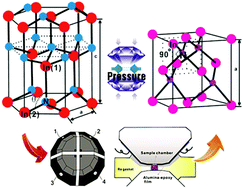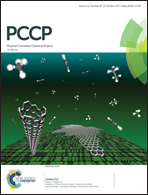Correlation between the structural change and the electrical transport properties of indium nitride under high pressure†
Abstract
We report on the intriguing structural and electrical transport properties of compressed InN. Pronounced anomalies of the resistivity, Hall coefficient, electron concentration, and mobility are observed at ∼11.5 GPa, accompanied by a wurtzite–rocksalt structural transition confirmed using high-pressure XRD measurements and first-principles calculations. The pressure-tuned electrical properties of wurtzite and rocksalt InN are also studied, respectively. Particularly, compression pressure significantly decreases the electron concentration of rocksalt InN by two orders of magnitude and increases the mobility by ten fold. The obvious variations in electrical parameters can be rationalized by our band structure simulations, which reveal a direct–indirect energy crossover at 10 GPa, followed by the rapidly increasing patterns of the energy gap with a pressure coefficient of 33 meV GPa−1. Moreover the electron effective mass and energy gap are found to well satisfy with the k·p model. Definite correlation between the structural change and the electrical transport properties should shed a new light on building InN-based applications in the future.



 Please wait while we load your content...
Please wait while we load your content...